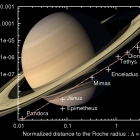Special Talk: Satellite Formation from Rings
Satellite systems are often seen as mini-planetary systems, and they are as various and complex. The Earth has one single satellite of more than one percent of its own mass, but the giant planets have many, some of them tiny. They constitute fascinating, interacting, evolving, and dynamically complex systems. While irregular satellites, having inclined and eccentric orbits, are supposed to be captured, it was generally admitted that regular satellites, having circular orbits in the equatorial plane of their host planet, formed in the gas and dust circum-planetary disk that surrounded giant planets at the time of their formation, more or less similarly as planets formed in the proto-planetary disk around their host star. Here, we propose an alternative mechanism for the formation of regular satellites: the spreading of a dynamically cold disk of solids beyond the Roche radius of a planet.
The Roche radius is defined as the distance from a planet beyond which self-gravity is stronger than tidal forces, allowing gravitationally bound aggregates to form, and satellites to exist. Saturn's rings are inside the Roche radius, which is why they don't coalesce into one single object. However, like any astrophysical disk in Keplerian rotation, they spread.
Once material reaches the Roche limit, it should accrete into moonlets.
These moonlets migrate outwards, repelled by tidal interactions with the rings and Saturn. We showed with numerical simulations that the small and mid-sized moons of Saturn formed this way, which explains their young age and composition (Charnoz et al. 2010, 2011).
Analytical calculations show that the formation of satellites from a ring of solids spreading beyond the Roche limit takes place in 2 phases:
(i) the “continuous regime”, in which only one satellite forms (this regime prevailed for the moon-forming disk around the Earth) ; (ii) the “pyramidal regime”, in which a series of moons form, migrate outwards, merge... In this regime, the satellites should follow a precise mass-distance relation, which matches that of the Saturnian system, confirming that it formed this way. It also fits the Uranian and Neptunian systems, suggesting that these planets used to have massive rings that gave birth to their regular satellites, and vanished (Crida & Charnoz 2012).
Refinements of this model, applications to planetary systems, and a recent likely observation of this process will be discussed in conclusion.

